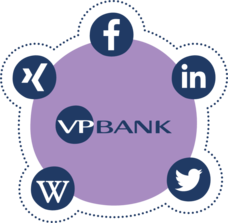VP Bank’s social networks
Social media is a general term used to cover media in which Internet users share experiences, opinions, impressions and information. These media include such well-known social networks as XING, Facebook and LinkedIn, as well as information portals such as Wikipedia or music, photo and video sharing platforms such as YouTube and flickr.
Global networks
Using social media, companies can expand their reach and the frequency of their communications and create greater proximity for dialogue with their target audiences.
The rapid growth in user numbers attests to the power of these networks. At end-2015, Facebook had approximately 1.5 billion active users worldwide, and in Liechtenstein and Switzerland the number is more than 3.5 million – more than half of all online users. Twitter has nearly 320 million subscribers, while the LinkedIn business network has more than 400 million profiles. Meanwhile, companies are increasingly opening up to these new, direct channels. International studies show that the majority of companies already communicate using social media for both their client business and their business-to-business activities.
Social media in the financial world
The nature of communications has changed dramatically through social media. It is no longer sufficient to simply have a web page and pick up clients with brochures. Clients are better informed than ever and can easily compare products and services amongst themselves. The easier it is for potential clients to find information on companies online, the more likely they are to deal with and contact the corresponding companies.
While the regulatory conditions surrounding privacy protection cause users to be cautious online, these communications channels nevertheless open up new opportunities for banks. The vast world of knowledge and topics of interest involving asset management and financing lend themselves to web research, the publication of knowledge and the exchange of information amongst experts.
Large banks use Facebook in order to promote their corporate involvement (events, sponsoring) and publicise product information to a broad public. Bank of America, one of the largest banks worldwide, uses most of the currently popular platforms. In addition to well-known channels such as Facebook, Twitter, YouTube and Instagram, newer platforms such as the video channel Vine also play a role. So far nearly 2.3 million people have “liked” Bank of America on Facebook, and the bank’s Twitter feed has 421,000 followers.
In the German-speaking banking world, Deutsche Bank set up a “Social Media Service”, where it engages in fast and direct dialogue through Twitter and Facebook. On the separate Facebook careers page, potential employees share their views with the bank.
VP Bank’s use of social media
Research studies show that when it comes to social media, private banks have some catching up to do. VP Bank is keeping its eye on the ball and increasingly tapping the benefits of social media. VP Bank’s motto is “safely ahead”, which also applies to communications.
VP Bank sees seven benefits of social media:
• Vast reach
• Proximity to interest groups
• Easier know-how transfer with brief content
• Rapid dissemination of information
• Direct dialogue to strengthen client loyalty
• More channels by which to distribute existing content
• More efficient means to recruit new employees
Since more than 56 per cent of VP Bank Group’s client assets come from the German-speaking regions (Liechtenstein, Switzerland, Austria and Germany), VP Bank’s social media content is mainly in German.
Outlook
Where does the online dialogue go from here? How will we communicate with clients, partners and (potential) employees in 10 years? Photo-sharing platforms such as Instagram have surged in popularity, with more than 400 million profiles worldwide, while the chat application Whatsapp now has more than 900 million users. Live streaming services such as Meercat or Periscope make it possible to provide a live feed on the Internet using just a smartphone, which was unthinkable just a few years ago given the limited bandwidth and hardware capabilities at the time.
These services are being used in ways that extend far beyond their original purpose of, say, sharing photos. Now people and companies use them for information, discussions and research. For VP Bank and its messages, these services create opportunities for closer client relations, an expanded reach and new channels for dialogue. VP Bank’s social media team carefully monitors the developments and evaluates the experiences in order to continuously expand its social media footprint.
VP Bank is currently weighing the pros and cons of a social media intranet for employees. This intranet would use the tools and principles from known external social networks and make them available internally. VP Bank would thereby enable employees to make decisions more quickly, have more efficient work processes and faster information.
VP Bank’s channels
Wikipedia – the reference guide
English and German entries on Wikipedia contain general information about VP Bank, its history and the company’s key figures.
XING – the talent showroom
VP Bank uses this platform as an employer and to support its recruiting efforts with job offers. VP Bank maintains a company profile. All of VP Bank’s press releases and job listings are posted in the news stream. Many VP Bank employees network through this application and thereby increase the Bank’s visibility.
LinkedIn – business networking platform
Much like XING, LinkedIn serves as an employer platform. It is widely used in the English-speaking countries. VP Bank is present on this platform through a company profile in both German and English. Job listings and all VP Bank press releases are posted in the news feed.
Twitter – rapid news service
VP Bank is positioned on Twitter with company and financial information. This channel is for the most part specialised; it is popular with financial media and journalists as a source of quick information. The news service offers the latest developments about the Bank such as press releases, financial market commentary and sponsoring activities. Since Twitter limits the length of the messages, the news releases sometimes include a direct link to the corresponding entry on the VP Bank web page.
Facebook – the best-known network
VP Bank is present on Facebook with an apprenticeship page. Apprentices and interns report on their day-to-day activity. They use Facebook to recount their personal impressions and experiences at VP Bank. These include experiences with the instructors as well as reports on trips, school and tests. The Facebook page is designed to give future and prospective apprentices a look behind the scenes and make them curious to learn more about apprenticeships at VP Bank.
Blog on www.vpbank.com
The www.vpbank.com website hosts a blog where VP Bank’s analysis and financial information is posted. It gives those interested an easy way to be in contact with VP Bank experts through the comments function.
In addition to social media channels where it is already active, VP Bank is also looking into other channels such as YouTube and Google+. The social media commitment is administered centrally by the Corporate Communications department.
VP Bank website
On VP Bank’s website, the “Social Media” section lists the various social media channels used by VP Bank. Links lead the user directly to the platforms and thereby facilitate interaction with VP Bank. Readers can also share interesting news and press releases by adding the corresponding Facebook, Twitter, XING and LinkedIn icons to their personal pages.
Internal communications
Although social media primarily targets external audiences, employees are key multipliers. The intranet therefore includes a page that informs them about VP Bank’s social media channels and content as well as concepts and guidelines.
Employees are regularly informed about social media activities and encouraged to participate by liking or sharing items.
VP Bank has published social media guidelines on how to use social media. They define the policies for all employees and control the communications behaviour. The staff regulations and code of conduct are also binding for all social network activities. As a publicly listed company, stock market rules on ad-hoc disclosures must also be followed.


